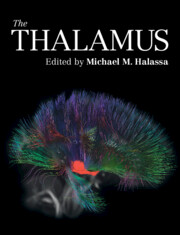Book contents
- The Thalamus
- The Thalamus
- Copyright page
- Contents
- Contributors
- Preface
- Section 1: History
- Section 2: Anatomy
- Section 3: Evolution
- Chapter 5 Morphological, Developmental, and Functional Evolution of the Thalamus
- Chapter 6 Lamprey Thalamus and Beyond
- Section 4: Development
- Section 5: Sensory Processing
- Section 6: Motor Control
- Section 7: Cognition
- Section 8: Arousal
- Section 9: Computation
- Index
- References
Chapter 5 - Morphological, Developmental, and Functional Evolution of the Thalamus
from Section 3: - Evolution
Published online by Cambridge University Press: 12 August 2022
- The Thalamus
- The Thalamus
- Copyright page
- Contents
- Contributors
- Preface
- Section 1: History
- Section 2: Anatomy
- Section 3: Evolution
- Chapter 5 Morphological, Developmental, and Functional Evolution of the Thalamus
- Chapter 6 Lamprey Thalamus and Beyond
- Section 4: Development
- Section 5: Sensory Processing
- Section 6: Motor Control
- Section 7: Cognition
- Section 8: Arousal
- Section 9: Computation
- Index
- References
Summary
The thalamus traditionally is divided into the dorsal and ventral divisions, with both divisions divided into groups of nuclei. More recent approaches have defined divisions based on functional features, development, and/or evolutionary relationships. The thalamic nuclei are inextricably related to the corresponding divisions of the telencephalon, which is now recognized to have four developmental pallial sectors (the medial sector–derived hippocampal cortices; dorsal sector–derived neocortex; and lateral and ventral sector–derived claustrum, pallial amygdala, and related lateral nuclei in mammals) and the subpallium (which includes the septal nuclei, subpallial amygdala, and basal ganglia in mammals). The two evolutionary divisions of the dorsal thalamus, present in all jawed vertebrates, are the lemnothalamus and collothalamus. In amniotes, elaboration of different pallial sectors and their related dorsal thalamic nuclei was divergent, with the lemnothalamic-related, allocentric spatial mapping abilities selected for early in the line to mammals and the collothalamic-related, egocentric spatial mapping abilities selected for early in the line to reptiles, including birds. Secondarily, the collothalamic system was elaborated in mammals (e.g., LP/pulvinar in primates) and the lemnothalamic system in reptiles (e.g., primary visual and somatosensory nuclei in birds). Commonalities of thalamotelencephalic circuit motifs evolved in both lineages, supporting the functions of complex cognition and consciousness.
Keywords
- Type
- Chapter
- Information
- The Thalamus , pp. 91 - 124Publisher: Cambridge University PressPrint publication year: 2022

